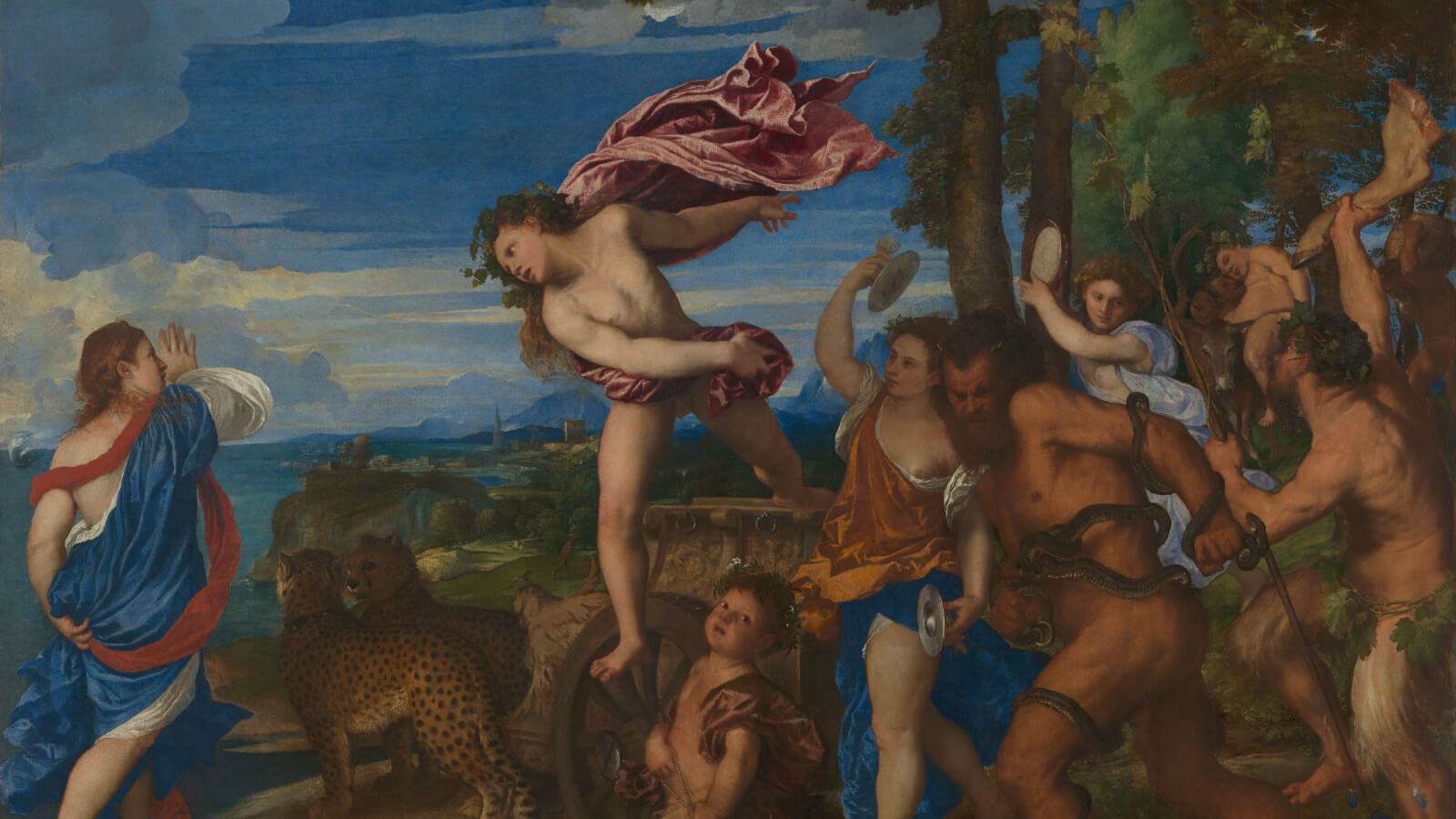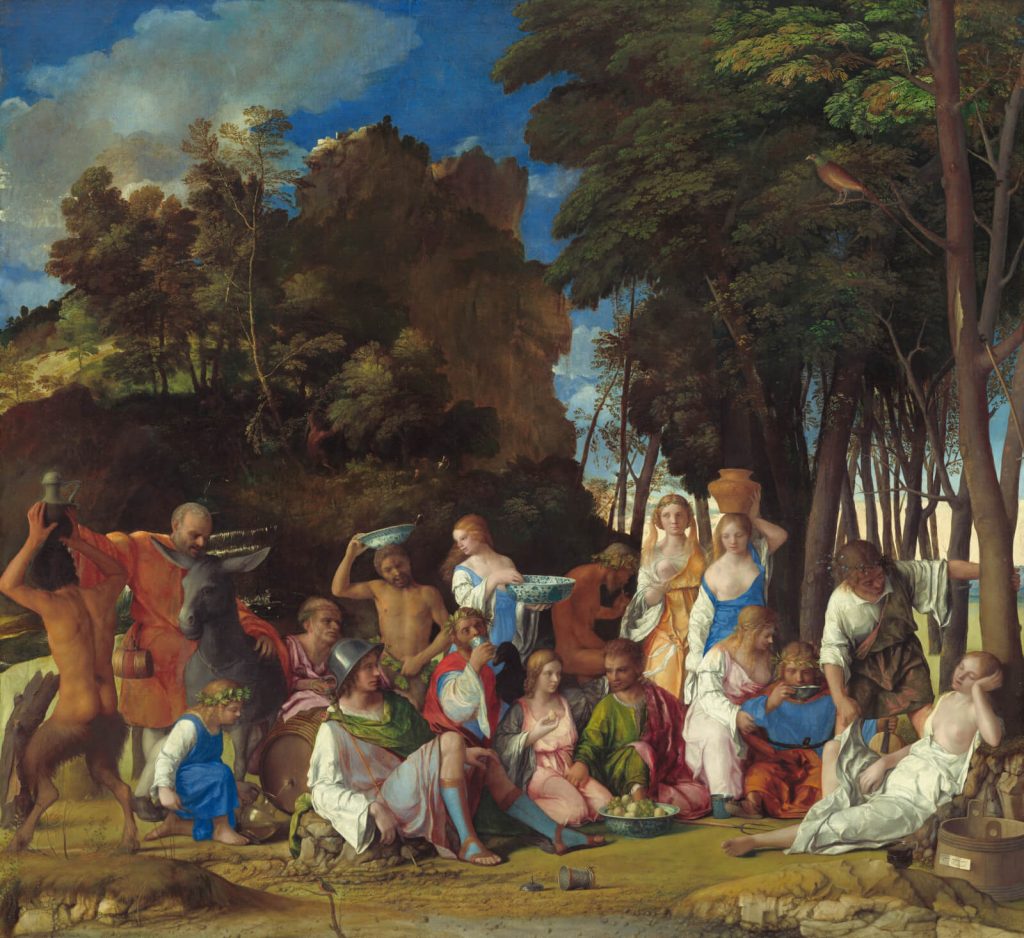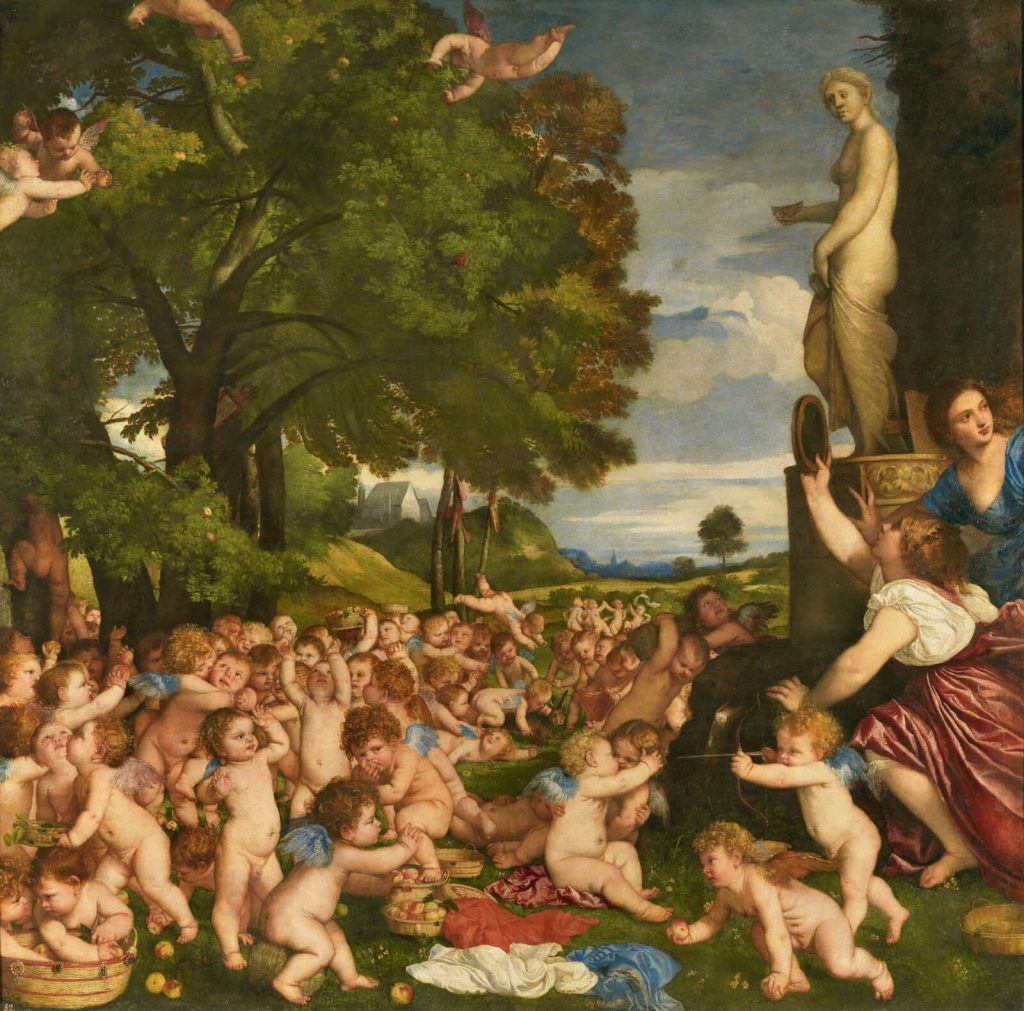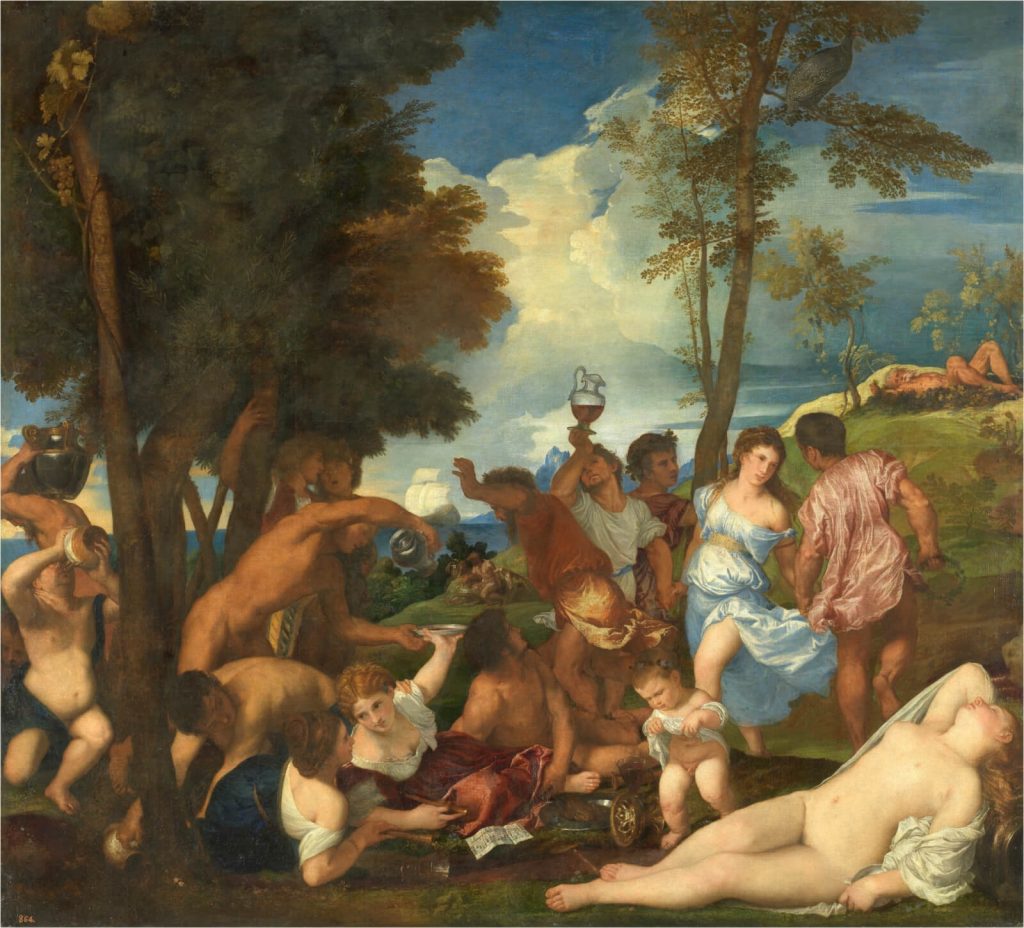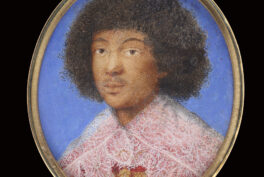Summary
- Titian’s Bacchus and Ariadne was commissioned by Alfonso I d’Este and Lucrezia Borgia for their Ducal Palace of Ferrara. The masterpiece status it achieved reflected how painting became a significant medium in Renaissance art.
- The composition of this oil on canvas resembles that of an ancient Roman relief. Bacchus is presented jumping off his chariot the moment he catches sight of and falls in love with the Cretan Princess, Ariadne.
- Ariadne, known for helping her lover, Theseus, escape the Labyrinth, stands here betrayed and abandoned.
- Bacchus’ followers join him in an ecstatic, hedonistic parade. Among them are satyrs, Bacchantes, and a drunk Silenus.
- The depiction of a man with snakes, a symbol of fertility, is modeled after the Laocoön statue.
- The cheetahs are likely based on the animals from Alfonso I d’Este exotic menagerie; the cocker spaniel could be Titian’s final addition as a favorite animal of his patron.
- The flowers in the foreground are easily recognizable as the ones that bloom in early Spring. Trees were painted to bring more visual attention to a pale Ariadne.
- In the sky, we can see Corona Borealis, which was created from Ariadne’s wedding crown after she married Bacchus.
Historical Context
Alfonso I d’Este was the rich and influential Duke of Ferrara who lived from 1476 to 1534 during the Italian Renaissance. He lived in the Ducal Palace of Ferrara, Italy, with his notorious and controversial wife, Lucrezia Borgia. The power couple were great patrons of the arts. When they decided to build and decorate their Camerino d’Alabastro (Alabaster Room), they naturally wanted to commission the most famous painters of their day. They, therefore, engaged Michelangelo, Raphael, and Fra Bartolomeo. Michelangelo failed to submit anything and defaulted on his commission. Raphael and Fra Bartolomeo submitted preparatory sketches, but both died before beginning their paintings. Hence, Alfonso and Lucrezia had to find replacements in a second round of commissions. They contacted Giovanni Bellini, Dosso Dossi, and Titian.

Titian, Portrait of Alfonso I d’Este, 1530-1534, Fondation Bemberg, Toulouse, France.
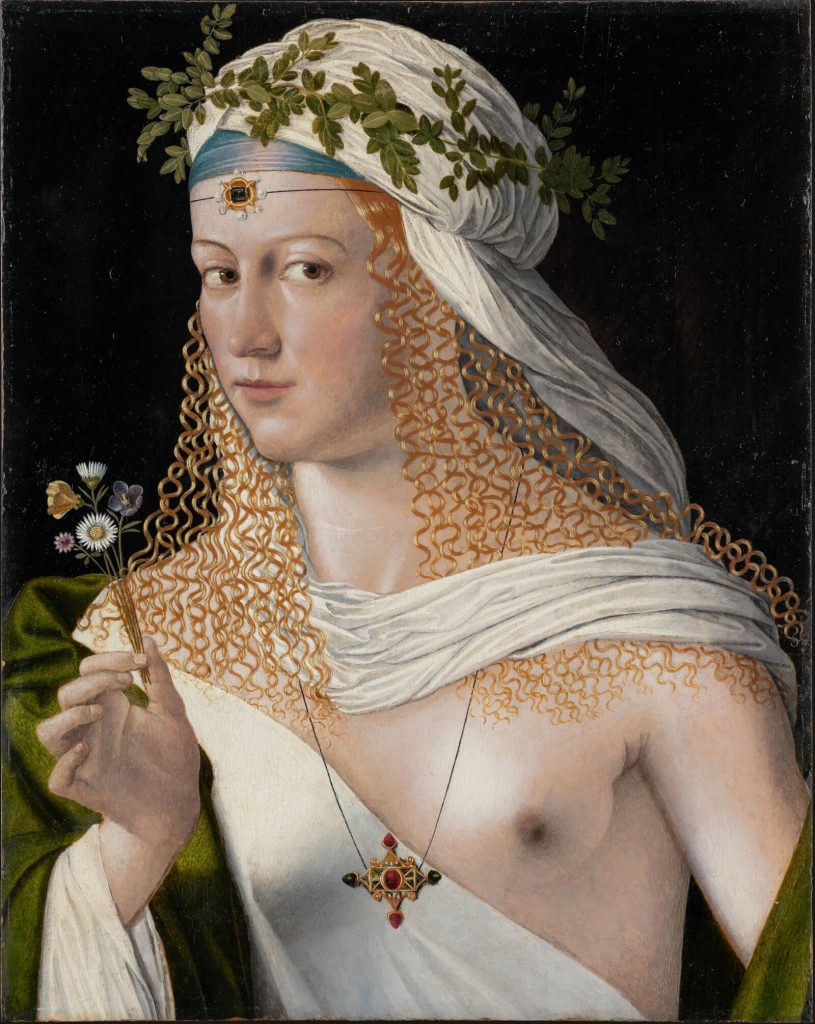
Bartolomeo Veneto, Portrait of Lucrezia Borgia, ca 1520, Städel Museum, Frankfurt, Germany.
Bellini and Dossi had established reputations across mainland Italy, but Titian was a newly rising star in the Venetian art world. His reputation was not solid; he was a risk. And Titian knew that he was second-choice to Raphael. Consequently, he knew this assignment would determine his status outside of Venice. He wanted to outdo Raphael and show that he was his talented equal.
When Titian presented Alfonso I d’Este with his contribution, Bacchus and Ariadne, it was immediately achieved masterpiece status. It captured the vibrancy of a Greco-Roman myth through the lens of an Italian Renaissance painter. It joined Bellini’s Feast of the Gods on the walls of the small, intimate pleasure chamber. Titian also submitted Worship of Venus and Andrians, but his Bacchus and Ariadne is the masterpiece of his three submissions that rivals Bellini’s Feast of the Gods in refinement.
General Context
Titian’s Bacchus and Ariadne is a landscape-oriented oil on canvas that measures 191 cm wide by 176.5 cm high. Alfonso I d’Este sent the pre-cut blank canvas from Ferrara to Titian in Venice to ensure that the finished painting would perfectly fit into the intended space. Alfonso’s and Titian’s use of oil on canvas consequently set the almost-universal adoption of canvas as the new painting medium instead of the wooden panels used by artists of the previous generation. With the patron’s and artist’s promotion, oil on canvas became the new traditional standard for painters.
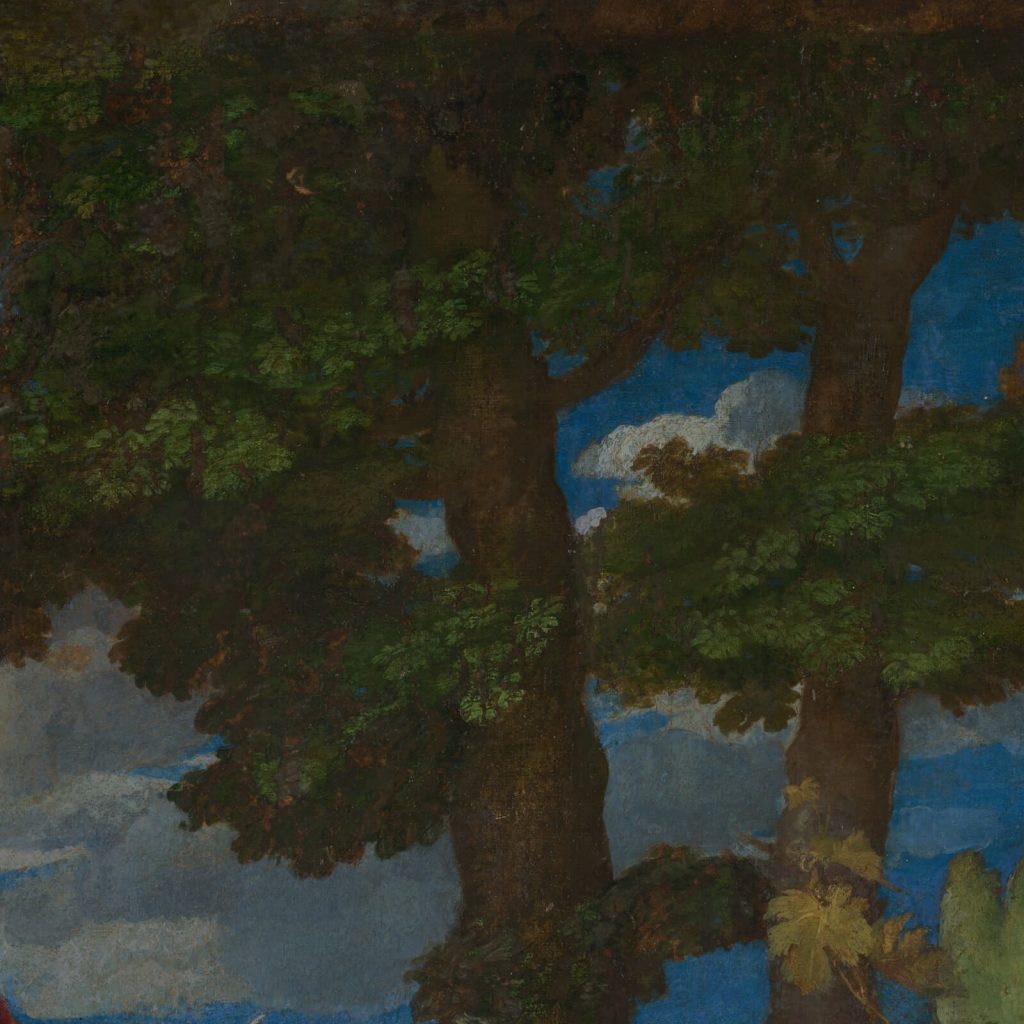
Titian, Bacchus and Ariadne, 1520-1523, The National Gallery, London, UK. Detail.
Bacchus and Ariadne captures the moment when Bacchus, the Roman god of fertility and wine, instantly falls in love with Ariadne, a mortal princess of Crete. Ariadne is the clothed female figure on the far left, and Bacchus is the nude male figure in the center. A crowd of Bacchus’s followers dominates the right side of the painting. Jointly, the overall composition resembles an ancient Roman relief like many found on ancient Roman sarcophagi and triumphal arches. The central chariot, the energetic bodies, and the dramatic poses all evoke Ancient Roman rituals and imageries around parades. Like a Roman army conquering a foreign land, Bacchus will soon conquer the heart of Ariadne.
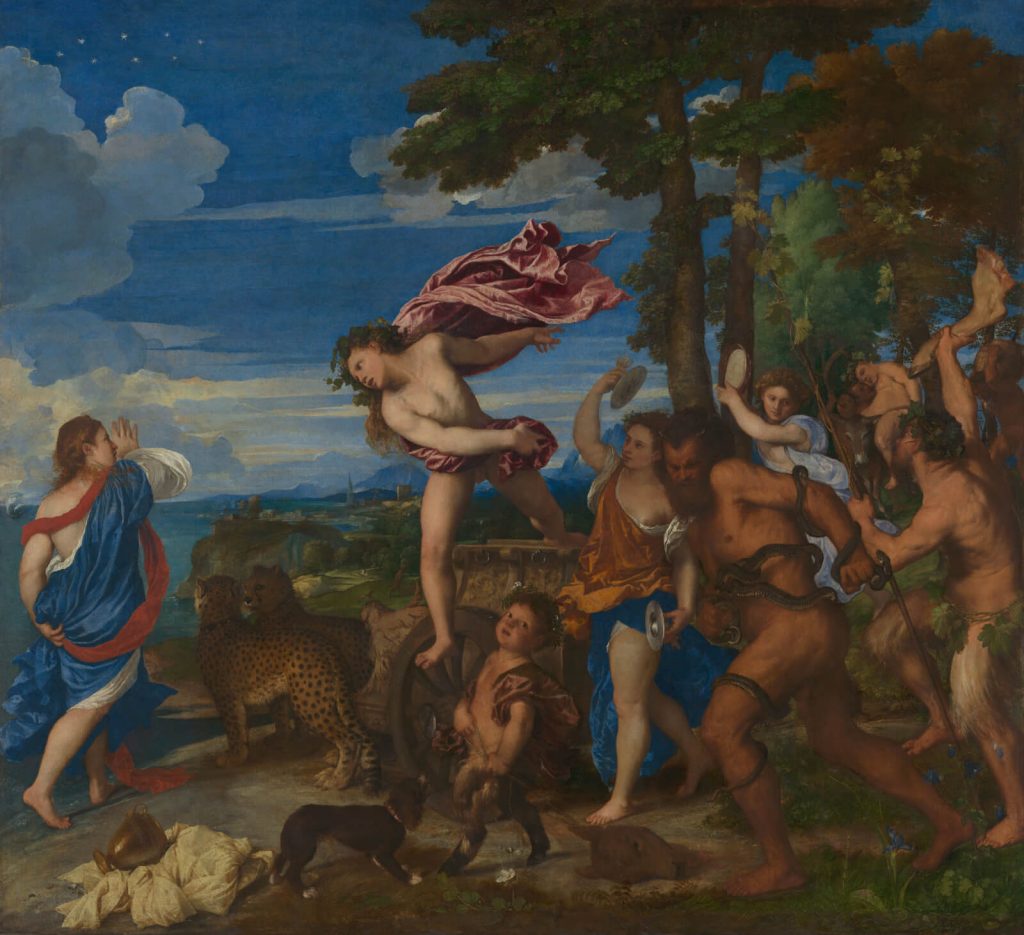
Titian, Bacchus and Ariadne, 1520-1523, The National Gallery, London, UK.
Bacchus
Bacchus was the son of Jupiter, the Roman king of the gods, and Semele, a mortal princess of Thebes and priestess of Zeus. In the painting, he is heroically nude with an ivy wreath on his head and a red cape around his shoulders. In this scene, Bacchus has just returned from a triumphal visit to India with his parade of followers, which include satyrs and Bacchantes. He has just arrived on the edge of a forest near the shoreline to discover a beautiful but distraught woman, Ariadne. He instantly falls in love with her. With eyes locked on her and full of love at first sight, he jumps from his cheetah-pulled chariot. Titian captures Bacchus’s leap, literally a leap of love, in a rare depiction of airborne motion in Renaissance art. Bacchus is painted suspended in the air with his left foot still on the chariot, his right foot hovering above the ground, and his body contorted in energetic descent. His red cape swirls around him and billows through the sudden burst of moving air.
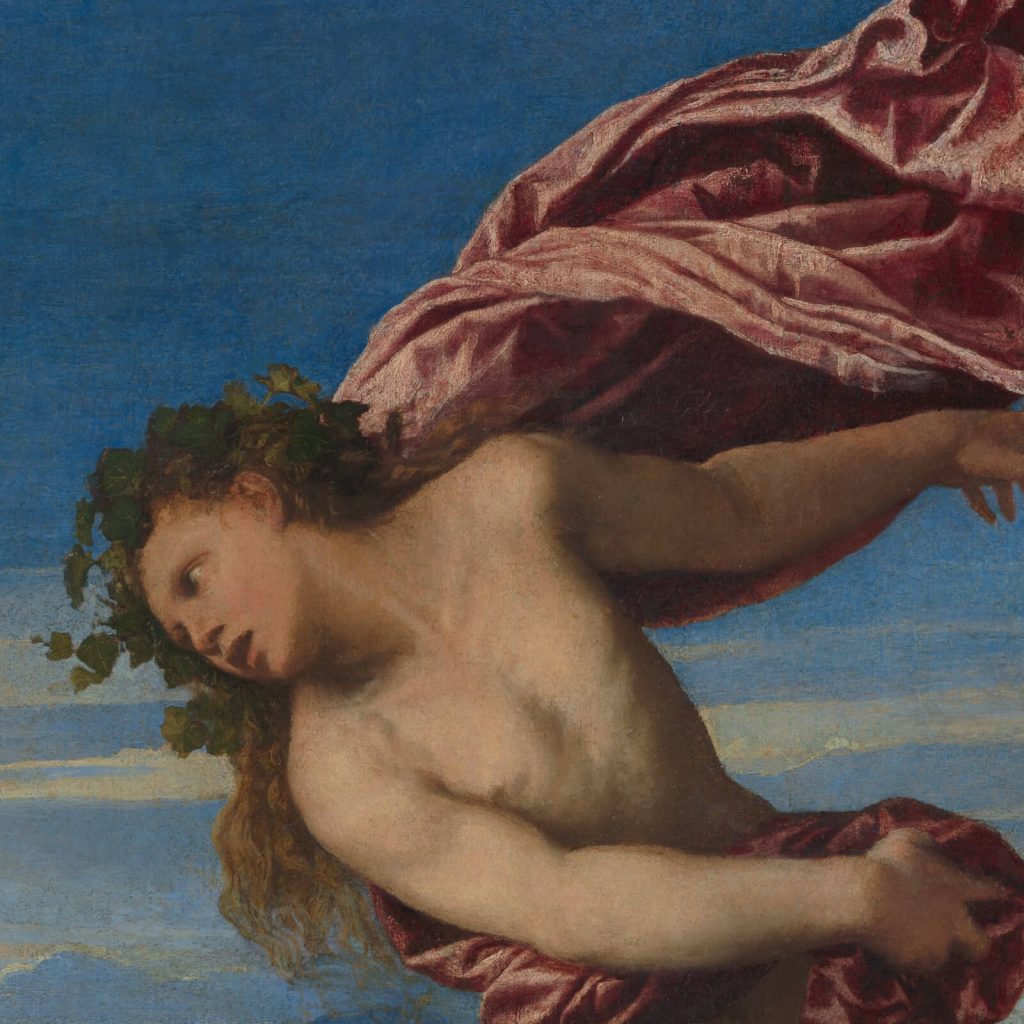
Titian, Bacchus and Ariadne, 1520-1523, The National Gallery, London, UK. Detail.
Ariadne
Ariadne, Bacchus’s love interest, stands on the far left side of the painting. She wears a pristine white chemise, a vibrant blue gown, and a long red scarf. Ariadne was the daughter of King Minos of Crete, who built the famous Labyrinth to confine the monstrous man-eating Minotaur. Ariadne helped Theseus, a prince of Athens and a possible son of Neptune, to escape the Labyrinth with a ball of string. Ariadne instructed Theseus to tie one end of the string to the Labyrinth’s entrance, enter the Labyrinth, find and kill the Minotaur, and then retrace his steps by following it. Having thus succeeded, Theseus runs away with Ariadne, and they become lovers.
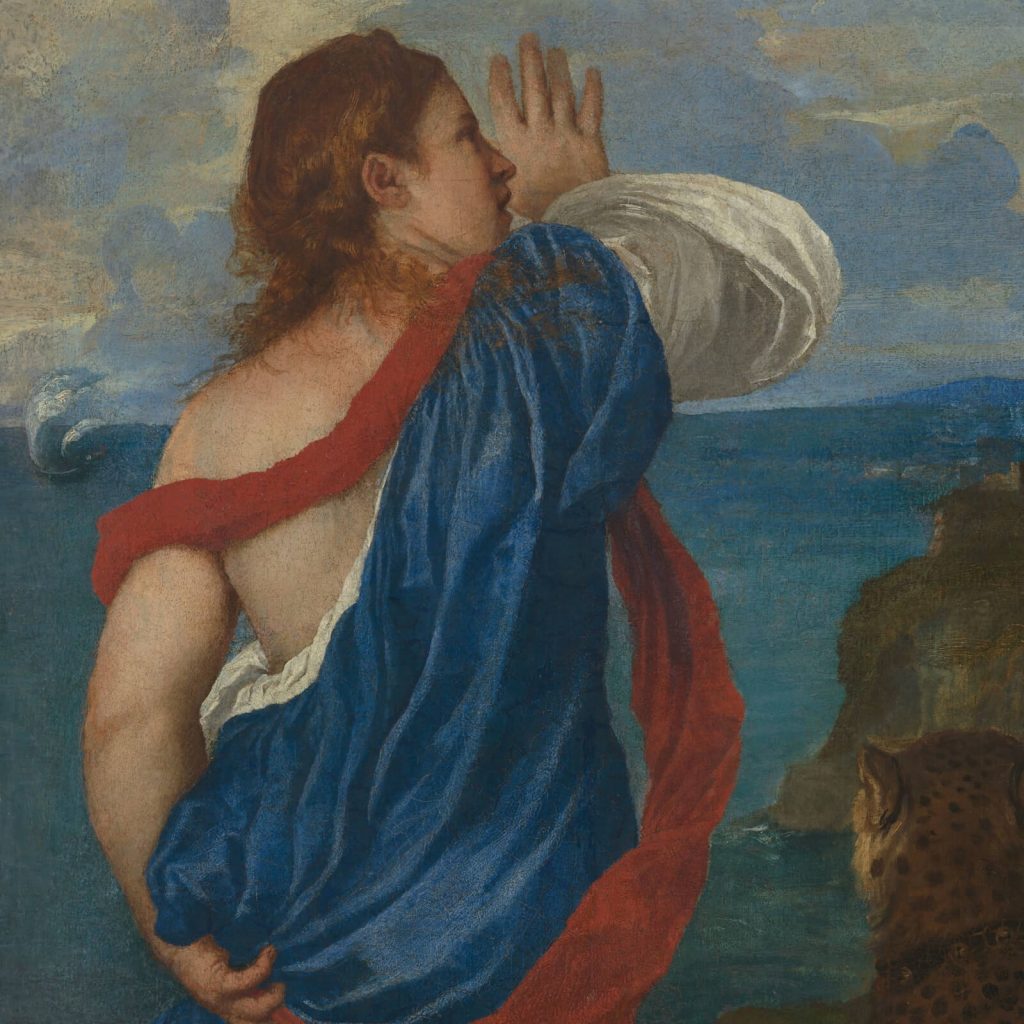
Titian, Bacchus and Ariadne, 1520-1523, The National Gallery, London, UK. Detail.
However, shortly afterward, Theseus tires of Ariadne and abandons her on the shore of Naxos, a Greek island. Thus, in the painting, Theseus sails away in his boat near the painting’s left horizon. Ariadne is stunned by Theseus’s ungrateful betrayal and her sudden lack of security. She is now homeless, poor, and alone — a long fall for a former princess accustomed to living in a palace with money and attendants. Shock, anger, and worry must fill her mind.
Bacchus’s sudden arrival surprises Ariadne. It causes Ariadne to twist and turn like a ballet dancer, which the red scarf accentuates by wrapping around her body. Ariadne is initially afraid, and her outstretched hand and extended right leg imply she is beginning to flee. She sacrificed everything for a man who deserted her. Her trust in men is at an all-time low. Now, who is this nude charioteer jumping towards her? What does he want?
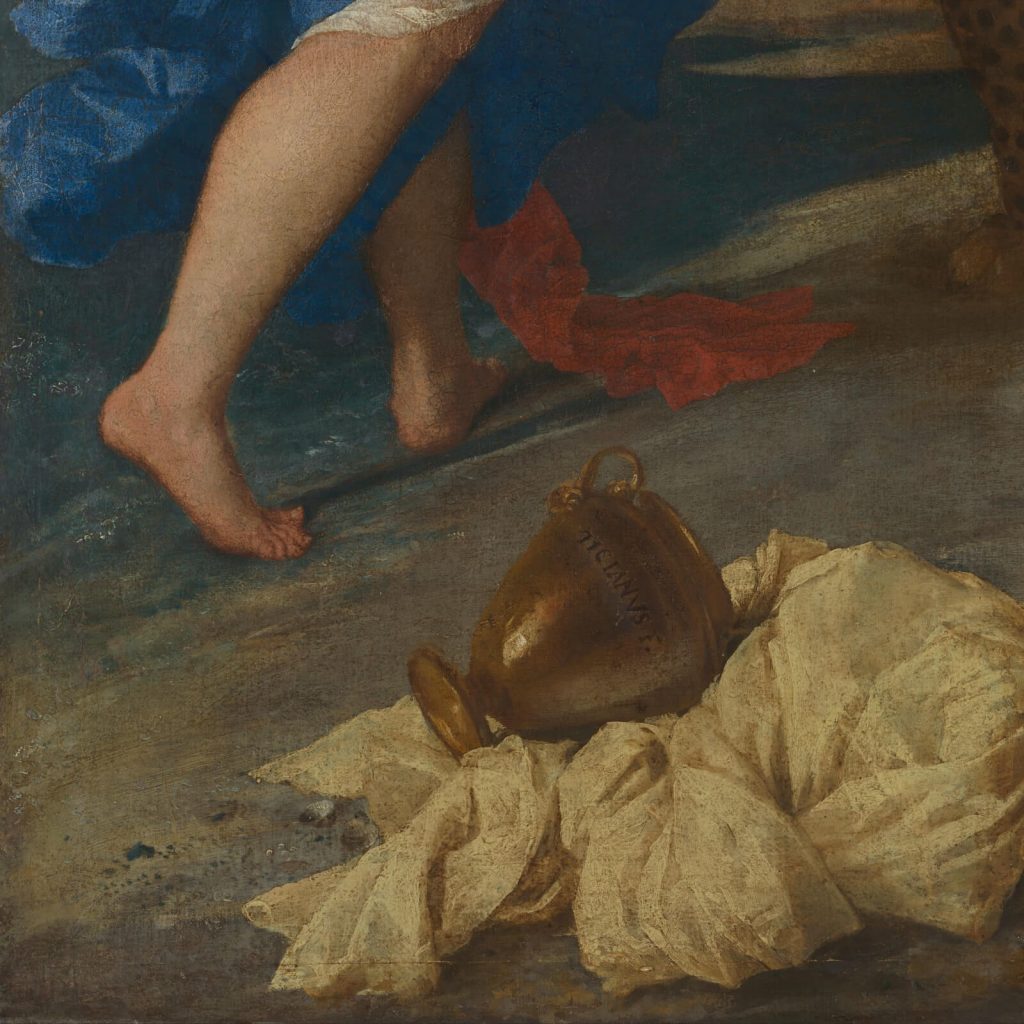
Titian, Bacchus and Ariadne, 1520-1523, The National Gallery, London, UK. Detail.
Bacchanalia
Behind Bacchus, to the right of the scene, are his many followers, including his tutor, Silenus, who drunkenly fell asleep on a donkey in the far right. Some of the other followers are satyrs, with the upper half of a man and the lower body of a goat. Their furry legs indicate their woodland origins. Satyrs are known for their lusty and drunken natures. They represent the uninhibited side of man.
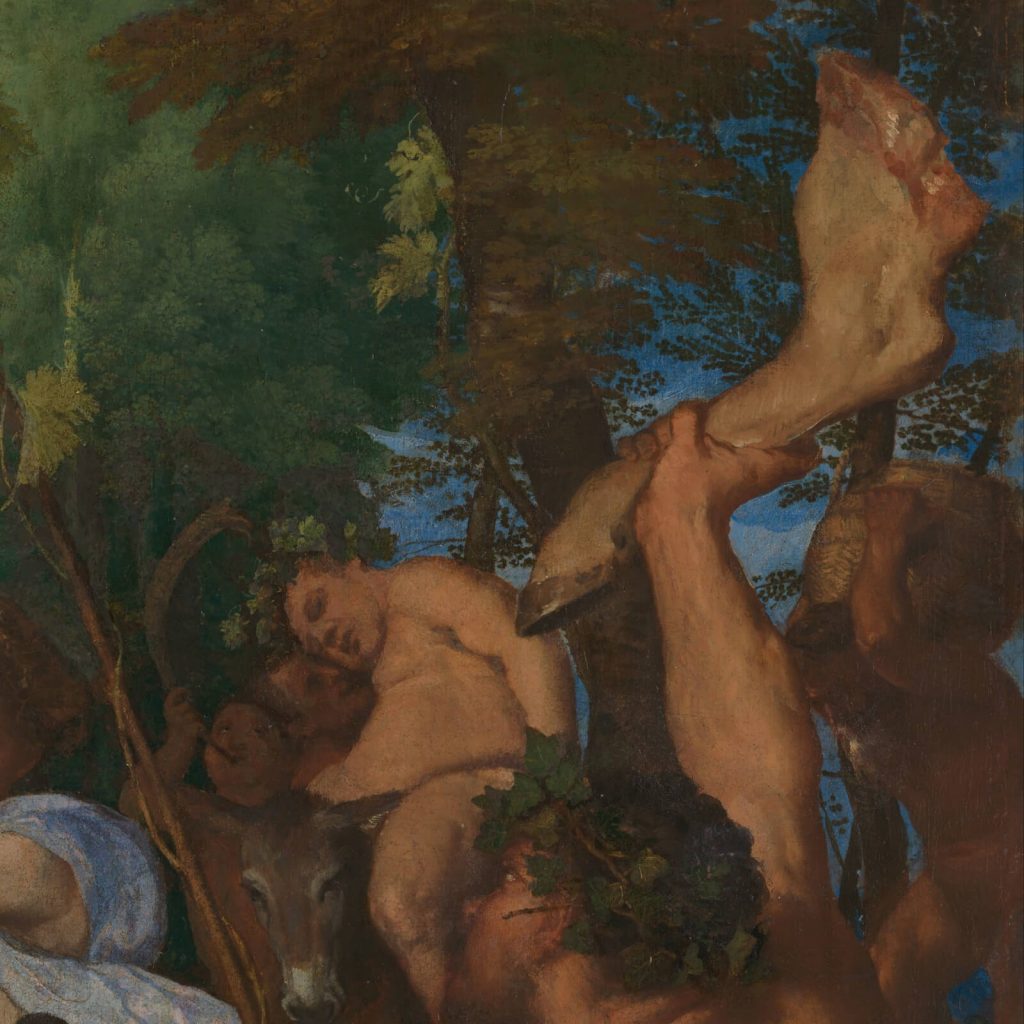
Titian, Bacchus and Ariadne, 1520-1523, The National Gallery, London, UK. Detail.
Alongside the satyrs are Bacchantes or Maenads, the women followers of Bacchus. In the painting, they are clashing cymbals and tapping tambourines. These female devotees would drink copious amounts of wine, reach ecstatic moments of trance, rip live animals apart, eat their raw flesh, then drink their blood. The Bacchantes believed by embracing such brutal savagery, they could achieve immortality. The remnants of their most recent animal victim are visible in the calf leg held aloft by a satyr on the far right and the calf head dragging on the ground in the bottom center.
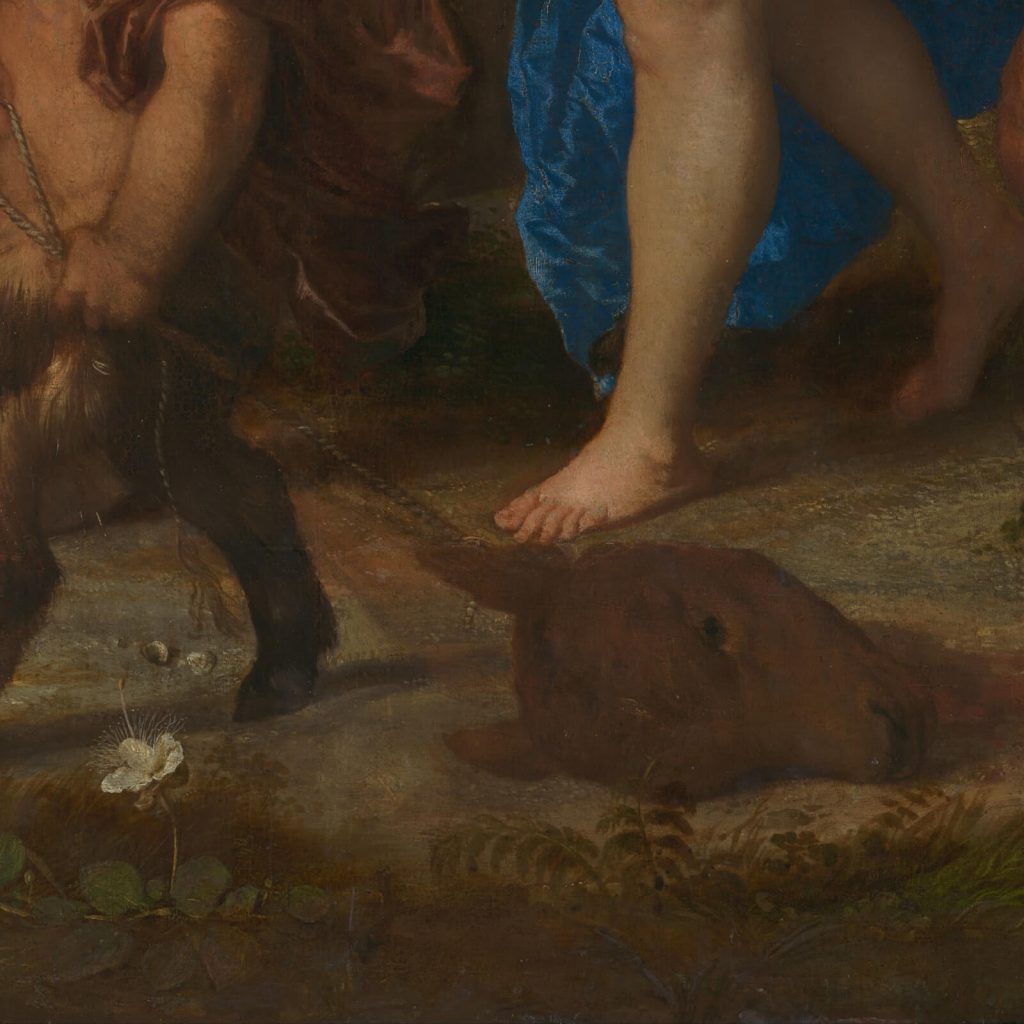
Titian, Bacchus and Ariadne, 1520-1523, The National Gallery, London, UK. Detail.
These rampaging followers of Bacchus would occasionally stop and host a Bacchanalia where drinking, dancing, sex, and animal sacrifice would be the party’s main events. Bloody hedonism was always the overarching theme.
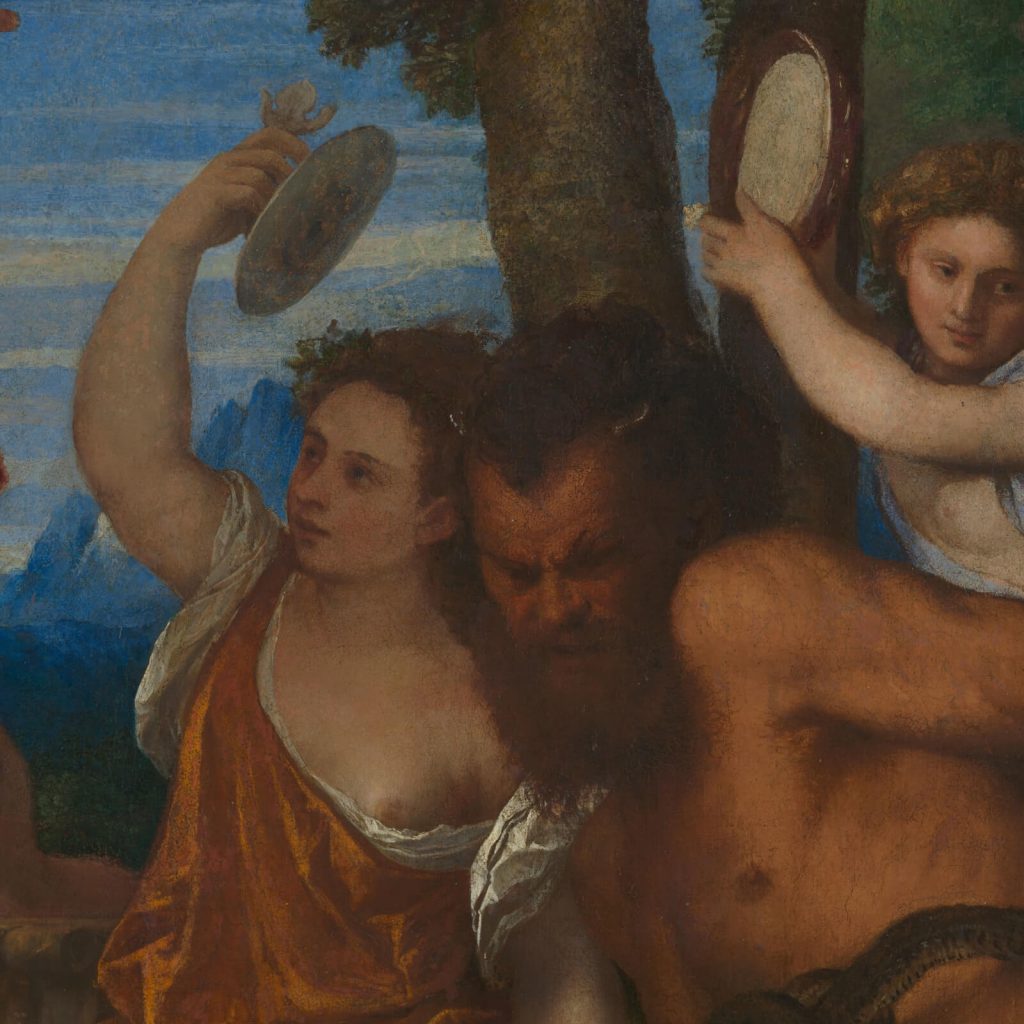
Titian, Bacchus and Ariadne, 1520-1523, The National Gallery, London, UK. Detail.
Laocoön
In the right foreground is a dark-tanned man with two largish snakes wrapped around him. Snakes, according to Roman mythology, represent death due to their venomous bites but also rebirth due to their skin shedding. The presence of this snake-wrapped man reflects upon Bacchus’s fertility. He also mirrors an archeological discovery contemporary to Titian by the way it seems directly modeled after the famous Laocoön statue unearthed in 1506. The statue was covered by many classical scholars in their writings, but no surviving example surfaced until 1506. Therefore, it became a weighty artistic find similar to the sensational discoveries of the ancient Egyptian Tutankhamun in 1922 or the ancient Chinese Terracotta Army in 1974.
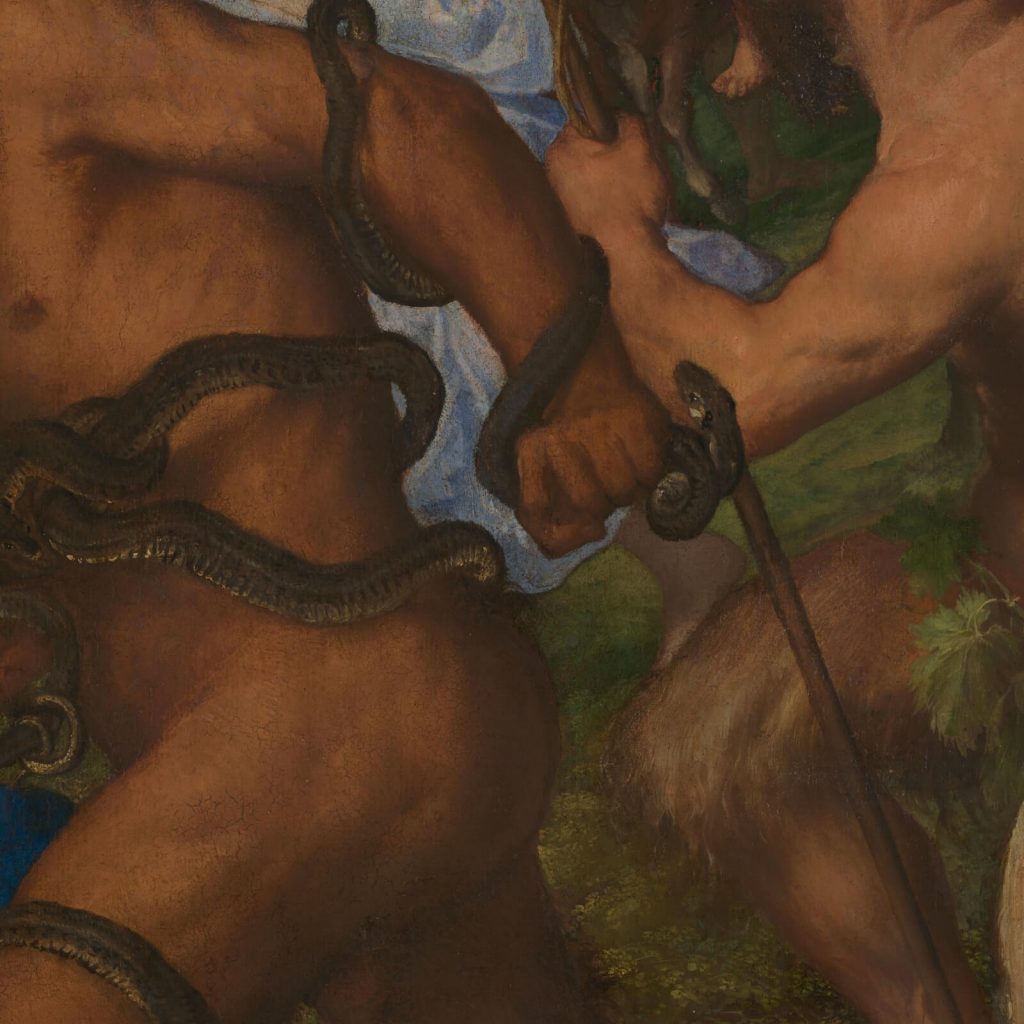
Titian, Bacchus and Ariadne, 1520-1523, The National Gallery, London, UK. Detail.
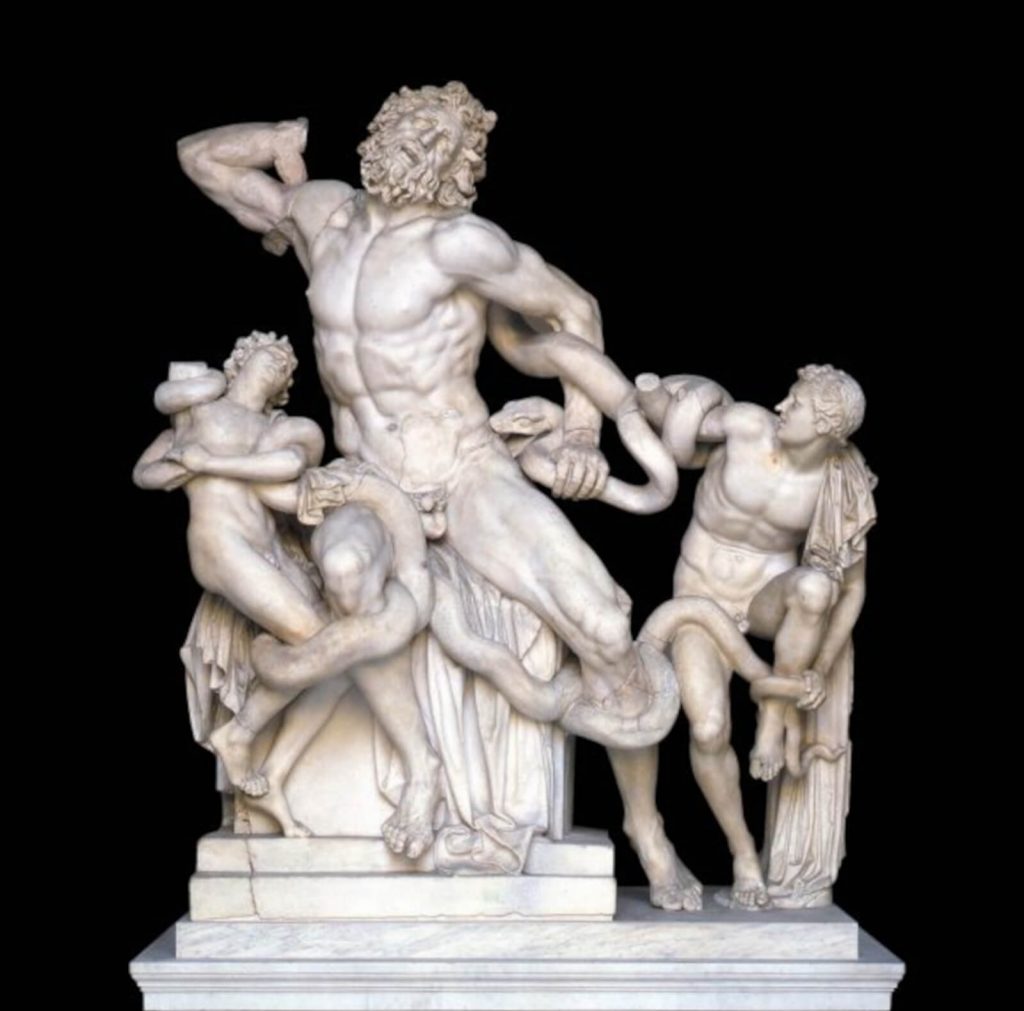
Agesander, Athenodoros, and Polydorus of Rhodes, Laocoön, 40-30 BCE, Parian marble, Vatican Museums, Vatican City.
Cheetahs
While Titian used Roman images to arrange his composition and to model his figures, he also used contemporary sources to reference his animals. Cheetahs are native to Africa, Iran, and India. They do not inhabit Europe, especially Renaissance Venice. Therefore, how did Titian depict an exotic animal so realistically?
Scholars believe that Titian’s patron, Alfonso I d’Este, had a menagerie or zoo that had a cheetah in its collection. Titian did visit Alfonso I d’Este in Ferrara before completing the painting and thus would have had an opportunity to observe, sketch, and include a cheetah in the painting. According to Ovid, an ancient Roman poet and recorder of many surviving Roman myths, Bacchus’s chariot was pulled by tigers, not cheetahs. However, Titian chose cheetahs. Perhaps he wanted something more exotic for Alfonso I d’Este? Or, Titian did not have the opportunity to observe a live tiger and substituted one large wild cat for another? Regardless of the reason, many modern viewers would agree that painting an observed realistic cheetah is a far better substitute than painting an unobserved unrealistic tiger. A silly-looking tiger would have spoiled the painting’s overall beauty.
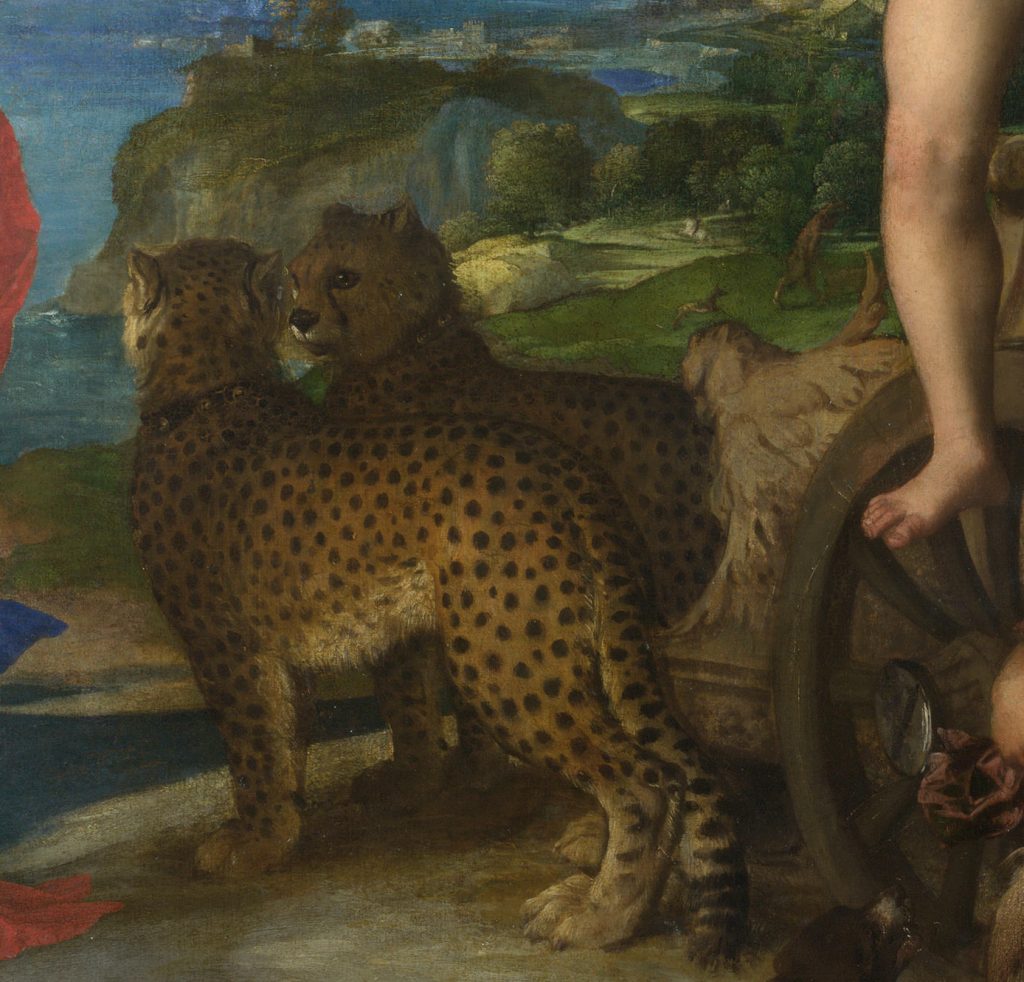
Titian, Bacchus and Ariadne, 1520-1523, The National Gallery, London, UK. Detail.
Cocker Spaniel
Titian’s contemporary animal sources continue with the brown cocker spaniel in the lower left foreground of the painting. It is barking at the child satyr dragging the severed calf’s head. Modern analysts have discovered that the dog was a final addition by Titian. The cocker spaniel did not appear in the original composition but was later added as a final touch. Modern historians believe Alfonso I d’Este asked Titian to add his favorite dog to the painting. Seeing an empty spot in the lower left corner, Titian willingly obliged his patron and added the barking brown cocker spaniel. Sadly, this beloved dog’s name is lost to history. But what a lucky dog to be immortalized by the great Titian. How so many people would want that honor!
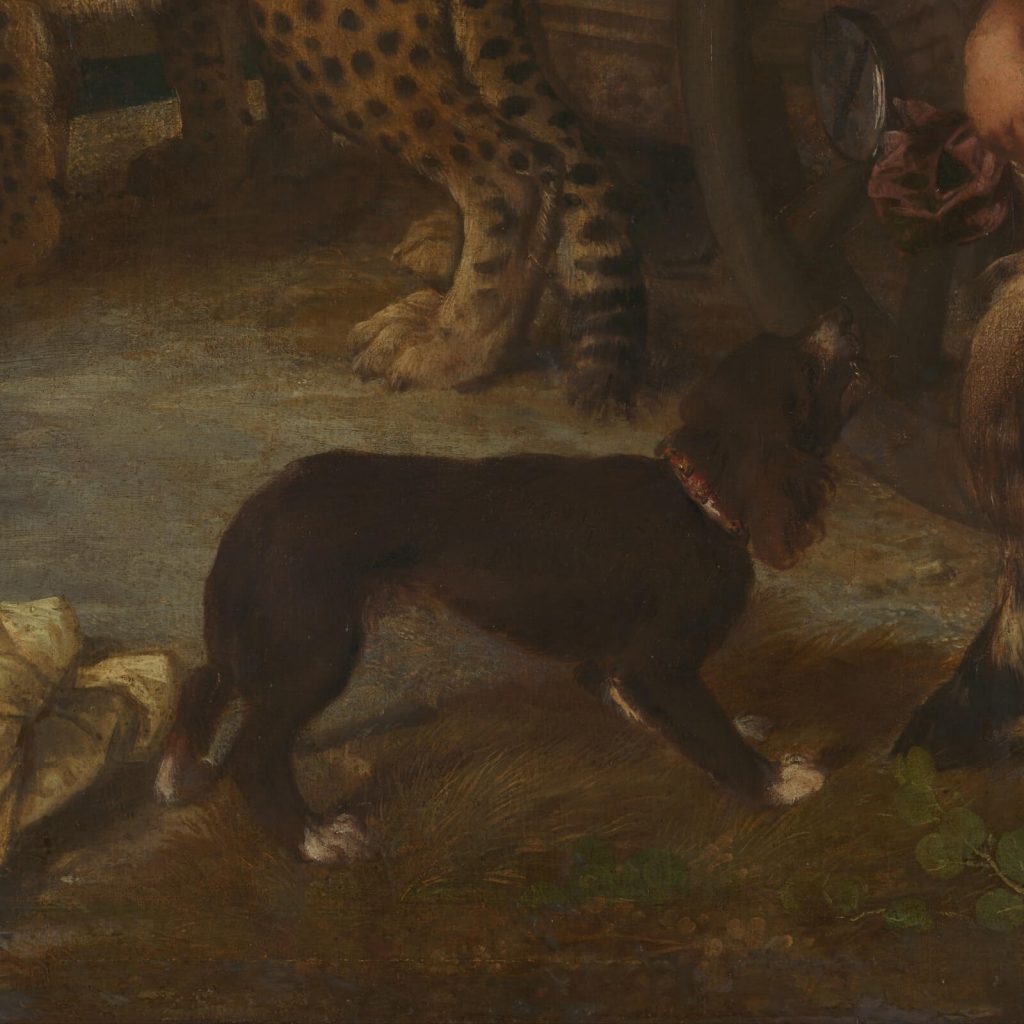
Titian, Bacchus and Ariadne, 1520-1523, The National Gallery, London, UK. Detail.
Flowers
As Titian took great pains in sourcing and painting his figures and animals, he devoted equal time to his trees and flowers. The flowers in the foreground are almost photographically accurate and render a great sense of realism to the landscape. They are easily identifiable as iris flowers, columbine flowers, and one caper flower. The blue irises are in the bottom right corner, the pink columbine flowers are to the left of the irises, and the white caper is farther left of the columbine flowers near the bottom center. These varieties of flowers bloom in late spring and early summer and indicate the painting’s season.
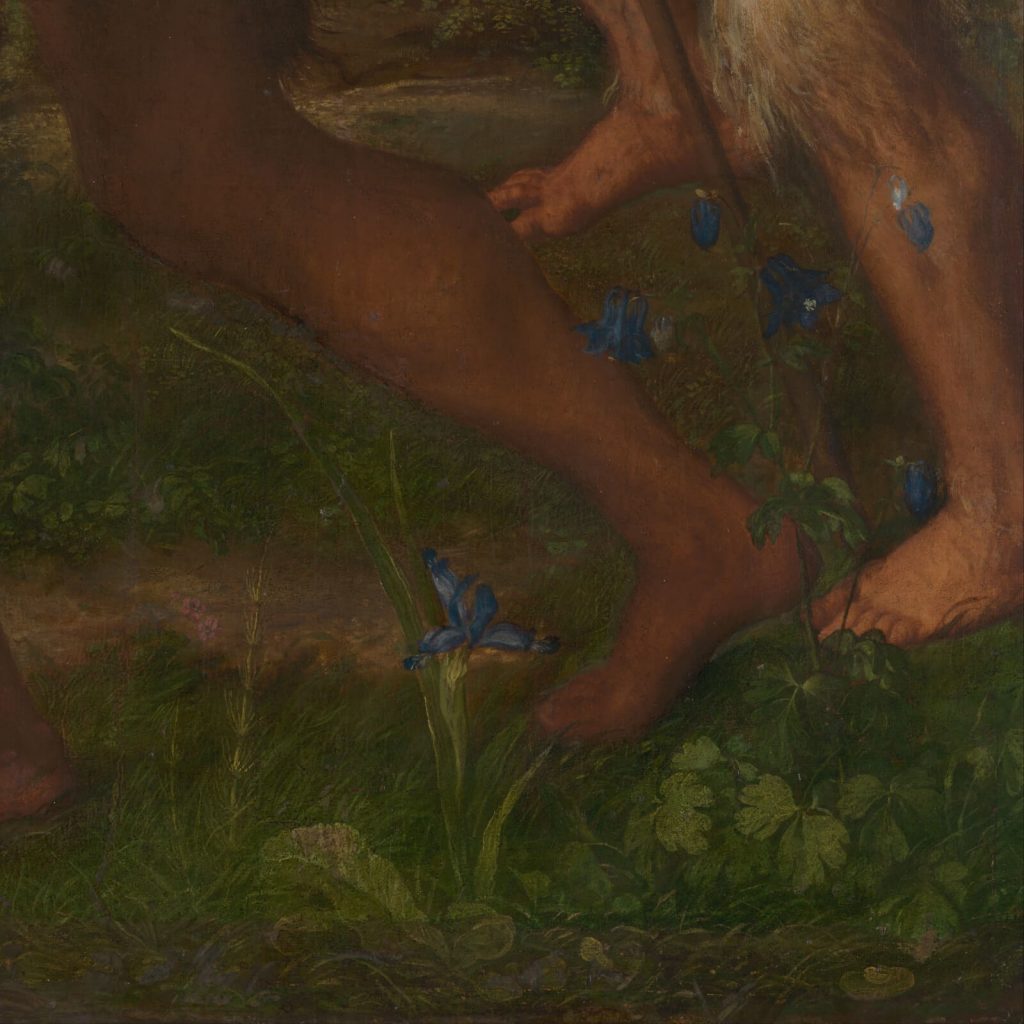
Titian, Bacchus and Ariadne, 1520-1523, The National Gallery, London, UK. Detail.
Trees
However, why is there an ochre-colored tree in the upper right corner? This painting is not set in the autumn season. Titian included this brown tree as a visual trick to create a sweeping diagonal line across the canvas. It begins with the tree, passes through the many brown bodies, skims the cheetahs, and ends with the creamy pale flesh of Ariadne. It is a dynamic gesture to draw the viewer’s eyes to the beautiful Cretan princess. She is the focus of Bacchus’s love and that of the painting. All eyes are upon her.
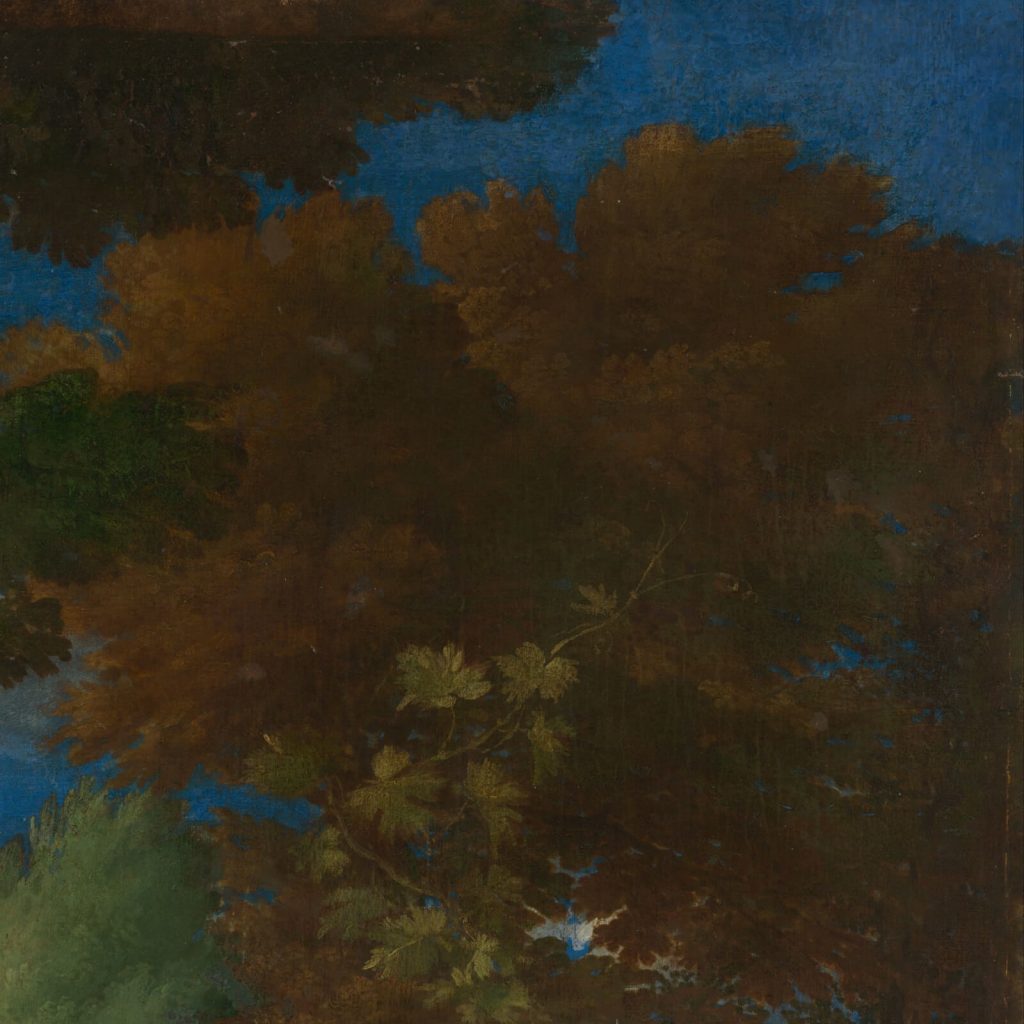
Titian, Bacchus and Ariadne, 1520-1523, The National Gallery, London, UK. Detail.
Corona Borealis
Titian captures the energetic and exciting first moment between Bacchus and Ariadne. However, what happens afterward? According to Ovid and Catullus, two ancient Roman poets and sources for this myth, Ariadne eventually returns the love of Bacchus, and she accepts his marriage proposal. At their marriage, Bacchus takes Ariadne’s wedding crown and throws it into the sky, where it becomes the constellation Corona Borealis. Titian alludes to this wedding’s happy ending by the circle of yellow stars in the painting’s upper left corner. Ariadne may have been duped by Theseus, but she is rescued and eternally loved by Bacchus. Everyone loves a happy ending. Omnia vincit amor. Love conquers all.
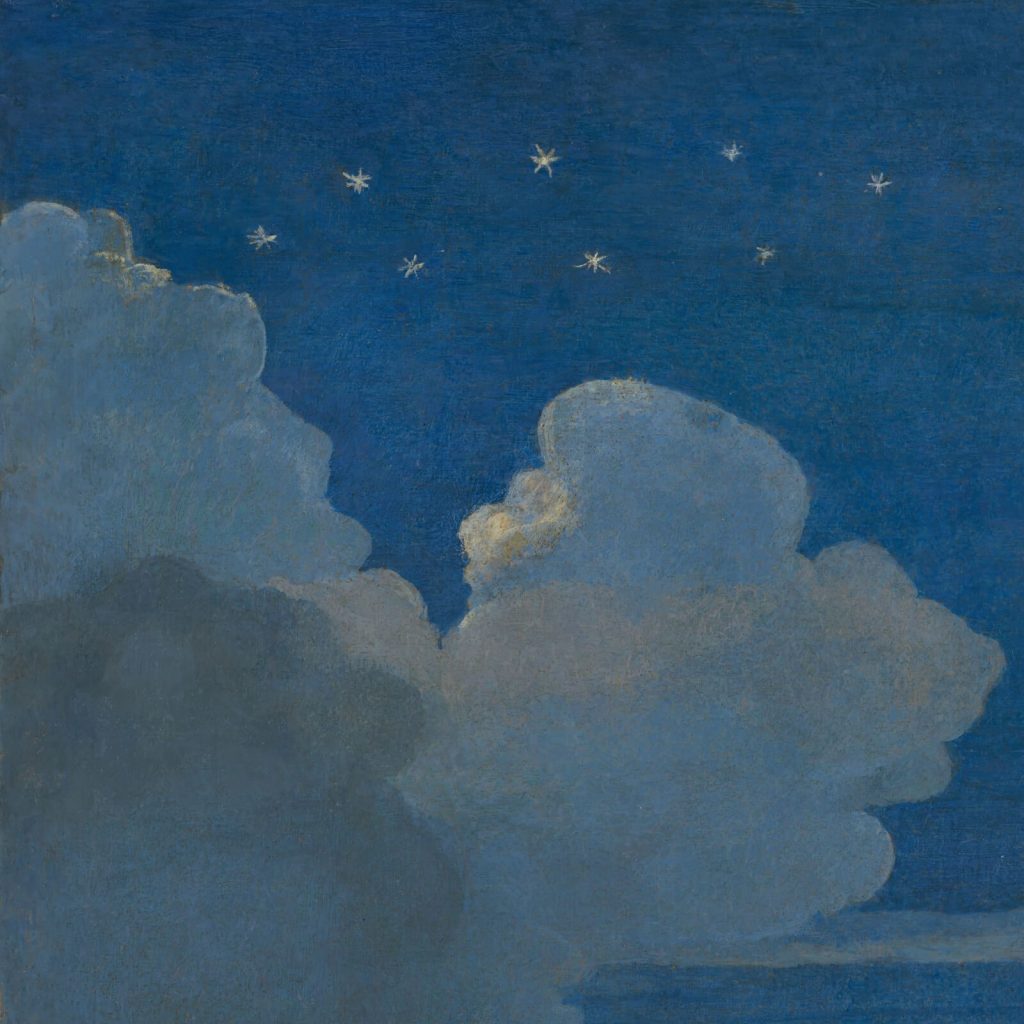
Titian, Bacchus and Ariadne, 1520-1523, The National Gallery, London, UK. Detail.
